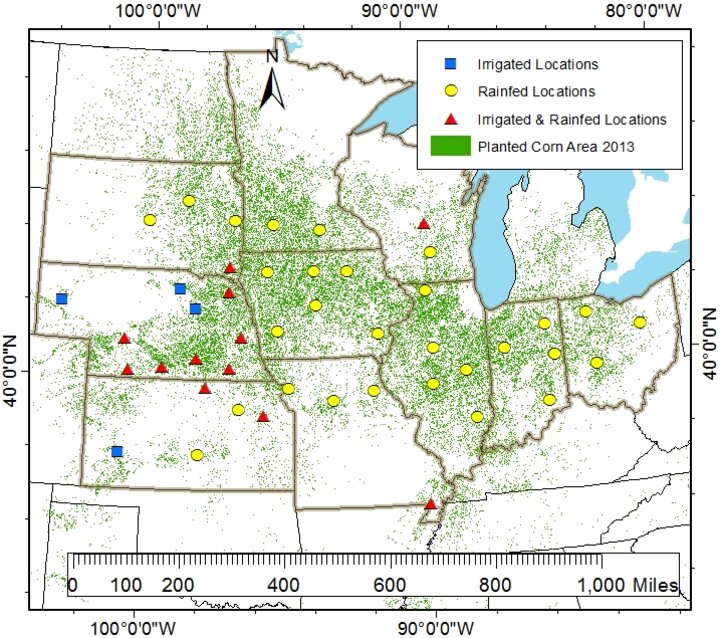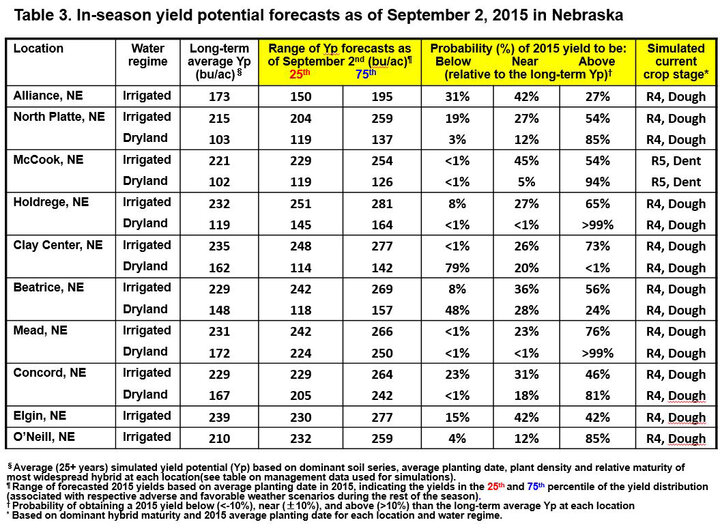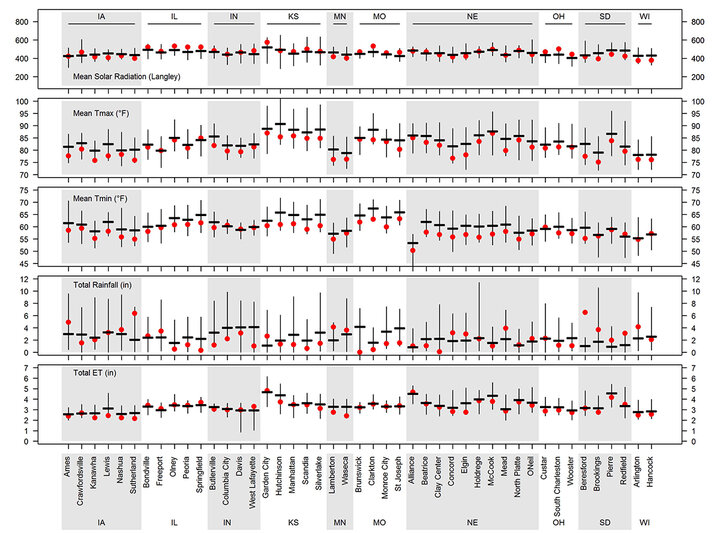Sept. 4, 2015

Figure 1. Locations used to simulate 2015 forecasted corn yields using Hybrid Maize.
See corn yield projections, as of Sept. 2, for these sites in Tables 3-5.
Corn is approaching the black layer stage and has already reached maturity in some southern locations. Since the last assessment of end-of-season corn yield potentials (August 14), temperatures have been consistently mild across all locations. To evaluate changes in the 2015 end-of-season corn yield potential, simulations were performed on Sept. 2 for the same 45 locations (Figure 1) using the UNL Hybrid-Maize model and in collaboration with faculty and extension educators from 10 universities. Details about Hybrid-Maize and the underpinning methodology to forecast end-of-season yields, as well as on interpretation and uses of yield forecasts, can be found in a previous CropWatch article.
Briefly, the Hybrid-Maize model simulates daily corn growth and development and final grain yield under irrigated and dryland conditions. The model estimates "yield potential." which is the yield obtained when the crop is not limited by nutrient deficiencies, diseases, insect pressure, or weed competition; conditions that represent an "optimal management" scenario. It also assumes a uniform plant stand at the specified plant population, and no problems from flooding or hail. Because weather, soil, and management factors are "location-specific," Hybrid-Maize simulations are based on actual weather data, soil, and typical management practices at the location being simulated as provided by university agronomists, extension educators, and DuPont Pioneer agronomists in each state (Tables 1-2). The results for simulation of end-of-season yields as of Sept. 2 are shown in Tables 3-5.

Irrigated Yields Expected To Be Near- Or Above-Average
The range of forecasted irrigated yields has narrowed relative to the last forecasts because crops are approaching black layer. Irrigated yields are likely to be near- or above-average at all irrigated locations. Moreover, there is a high probability (>66%) of above-average yields at 4 of the 10 locations in Nebraska (Holdrege, Clay Center, Mead, and O'Neill).
Dryland Yields

For dryland corn, there is a very high probability (>80%) of near- or above-average yield at all sites, except for Clay Center and Beatrice in Nebraska due to lower than average precipitation (Figure 2), and in Arlington, Wisc. due to high risk of an early-killing frost (Figure 3). At these three locations yield is likely to be below-average, however, yields can still be near-average if weather is favorable during the rest of the season. Overall, the yield scenario looks very good for dryland corn across the entire Corn Belt and, indeed, there is a high probability (>80%) of above-average yields in 28 of the 41 dryland locations. The probability of below-average yields is very low unless unusual yield-damaging weather occurs before the crop matures.
As in previous articles, a summary of recent weather conditions (daily solar radiation, maximum and minimum temperature, total rainfall, and total [grass-based] reference evapotranspiration (ET) for the time period between August 12 and September 1) is presented in Figure 2 to help interpret the forecast yields. Vertical bars indicate the range for these variables based on 20+ years of weather records. The horizontal thick line indicates the long-term average while the red dots indicate the 2015 averages.
Daytime temperatures have been mild throughout the Corn Belt, and nighttime temperatures have been below normal. In addition, reference ET has remained close to or slightly below (Iowa, Minnesota, Wisconsin and Ohio) normal throughout the region, while rainfall amounts have greatly varied across sites. The range of forecasted black layer dates for irrigated and dryland crops is shown in Figures 3-4. Corn has already reached black layer at many locations in Kansas, Missouri, and southern Illinois. The probability of an early-killing frost is high (>50%) in the northern fringe of the Corn Belt including at the Wisconsin, Minnesota, South Dakota, northern Iowa, and northern and western Nebraska locations (Figure 3).
Conclusions
With few exceptions, the yield scenario looks very good for both dryland and irrigated corn in the entire Corn Belt. The yield scenario is still uncertain for irrigated and rainfed crops in some of the northern locations due to the possibility of an early-killing frost and some south-central and southeast locations due to lack of rainfall. These forecasts do not take into consideration problems with stand emergence due to crop residues, hail/flooding damage, replanting situations, disease/insect issues, or nutrient deficiencies. Likewise, there can be late-season diseases and high winds or hail that can cause yield loss as the crop matures or awaits harvest. Therefore, in fields negatively affected by these constraints, actual yields will be lower than estimates provided here. We will follow up with further forecasts (or end-of-season yield if crop has already matured) by mid-September.
Note to Readers: We will be participating in Husker Harvest Days Sept. 15-17 in Grand Island and have a booth in the University of Nebraska Big Red building on Third St. We invite you to stop by so we can show you more about the Hybrid-Maize model and Yield Forecasting Center and welcome your feedback.
